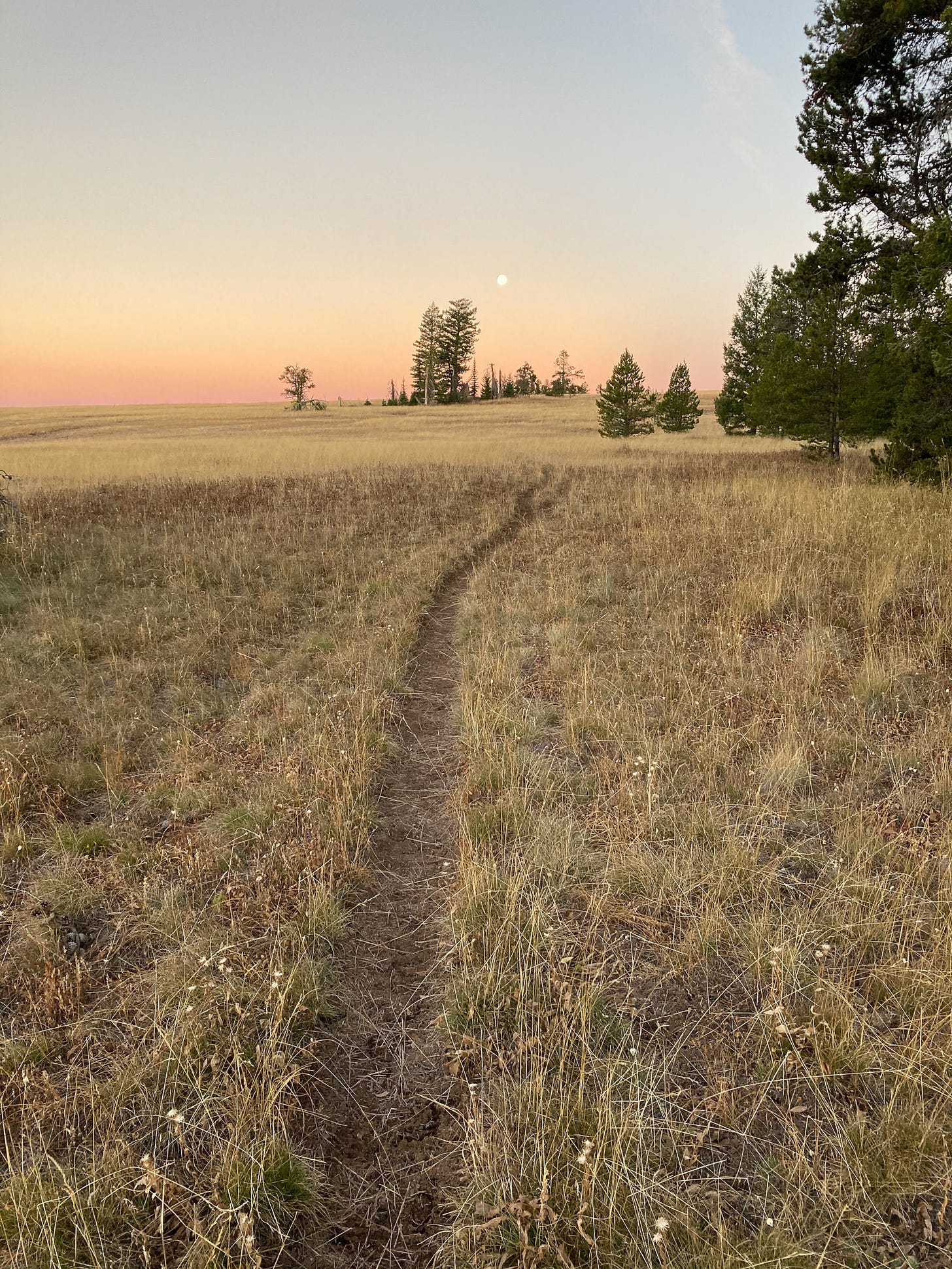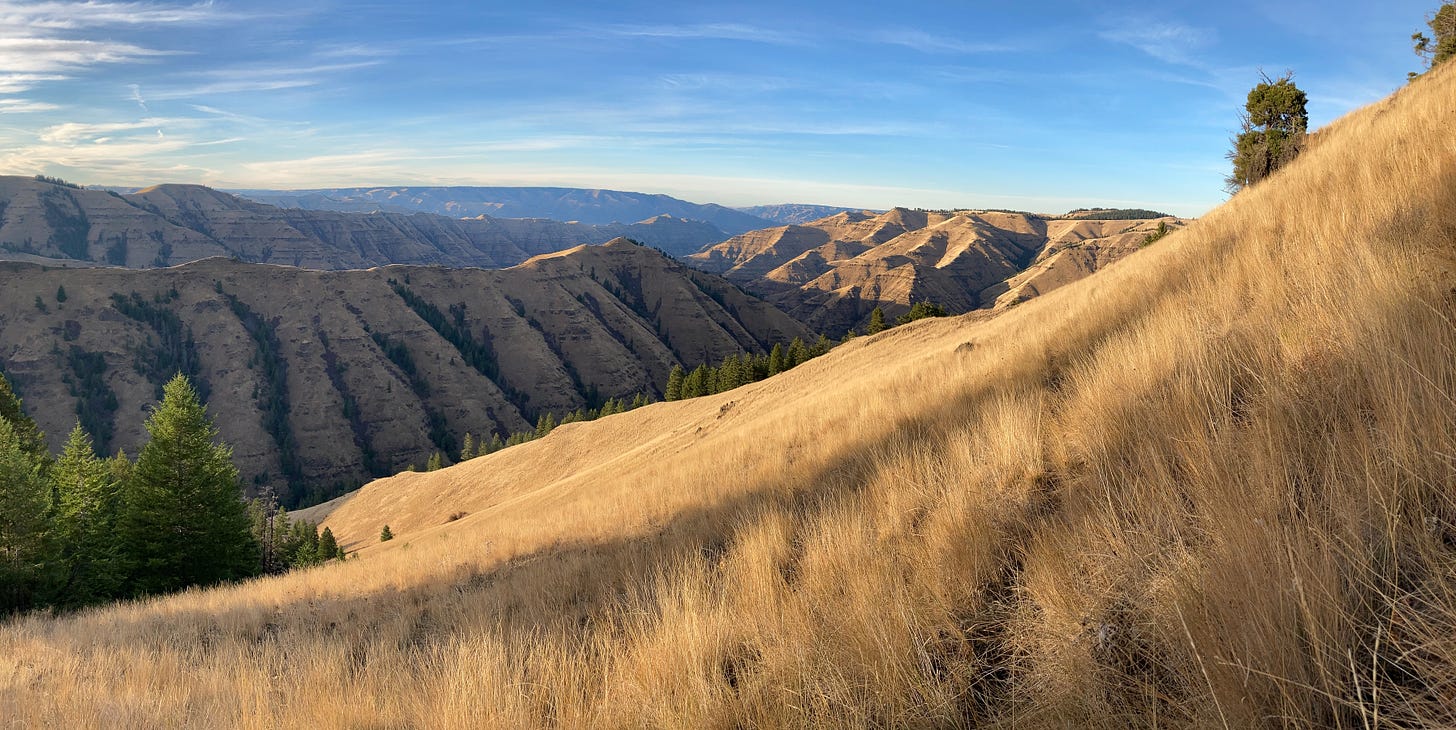Where Does Your Food Come From?
One small question that could save the world.
Welcome! I’m Max Wilbert, the co-author of Bright Green Lies: How the Environmental Movement Lost Its Way and What We Can Do About It and co-founder of Protect Thacker Pass. This newsletter focuses on sustainability, greenwashing, and resistance. You can subscribe for free. Paid subscribers get access to behind-the-scenes reports and unreleased drafts. If you get value from this newsletter, consider a paid subscription. Thanks!
This essay was originally published in Backcountry Journal in 2021, but this version contains material that was not included at that time. It tells the story of an elk hunt — a topic that may be contentious for some readers. There is good reason for this. Overhunting is a major driver of species decline and extinction in some areas of the world. Luckily, Rocky Mountain elk in my region have stable populations.
Be it plant, animal, fungi, or microorganisms, we eat other beings and are sustained by them. This essay is a reminder that sustainable food does not come from industrial monocultures (whether torturous factory farms or endless fields of monocrops), but rather from diverse polycultures, from functioning ecosystems, from thriving naturally evolving communities.
Elk, mushrooms, acorns, nettles, seaweed, trout, crawdads, camas bulbs, rosehips, clams; this is what grows where I live, when the land is free from concrete and plows.
“Life is not a predatory jungle, ‘red in tooth and claw,’ as Westerners like to pretend, but is better understood as a symphony of mutual respect in which each player has a specific part to play. We must be in our proper place and we must play our role at the proper moment. So far as humans are concerned, because we came last, we are the ‘younger brothers’ of the other life-forms, and therefore have to learn everything from these other creatures.”
— Vine Deloria, Jr.
Seven days deep in the wilderness, we sink further into the land with every passing hour. Deer, elk, bighorn sheep and pronghorn antelope are our neighbors. Bear and coyote tracks dot the fresh snow. Ponderosa and fir scent the air, and scarlet rosehips dot the hillside. October in the Western mountains.
Each morning, we’re up before dawn to track the herds. We spend long hours on hilltops, watching. Elk roam the slopes, but day after day they elude us. As the sun sets, we visit a tiny spring seeping from the hillside to quench our thirst and fill our bottles, then we make our way back to camp. We light a fire, drying clothes and boots, stretch our aching muscles, and eat, preparing for another pre-dawn start. Wolves howl as darkness falls.
Another morning, another hilltop. It’s frigid. We start a small fire and huddle for warmth, waiting for sunrise. As orange light crests the eastern mountain, I scan the upper sections of a forested drainage and spot movement. Adjusting my binoculars, the dots on the far hillside resolve into a herd of elk, one of them a young male. We quickly begin preparing to abandon our sunrise perch.
Methodically stuffing gear back in my pack, I throw it on my back, ratchet down the straps and stand. “I think we can get ahead of them if we cut straight downhill,” I tell my friend Carson. He nods, and we begin to drop off the game trail down the steep hillside, dropping 1000 feet in a quarter mile. We may only have minutes to get into position.
I start off too fast, my heart thundering, feet shuffling and tripping on rocks, sliding on dry grass, threatening injury. I force myself to slow down. “Slow is smooth, smooth is fast,” I say out loud. This is the motto of our trip. And then, to my partner and myself: “No falls.” We are 10 miles from the nearest road, 40 miles from the nearest hamlet and days from definitive medical care. This is no time to break an ankle.
Moving as fast as I can safely move, using gravity, bending my legs and leaning slightly forward to use the big muscles of the glutes, hiking poles for balance, we half run, half slide down the steep hillside.
As we approach the herd, we slow to a trot, then a walk. They are feeding in patchy forest, and we lose our quarry behind a tree, then spot him again. The steepness of the valley makes it possible to shoot across the ravine, and Carson carefully unlimbers his rifle. I hang back behind a rose bush, not wanting to spook the elk.
A minute later, a sharp crack sounds, echoing off the hillsides. I cannot see the spike, but the rest of the herd runs a few steps then freezes, unsure where the threat comes from. I wait. Did he miss? Is the elk down? I wait another 15 minutes, then 20. Suddenly, the elk take fright and move off northwards. Watching closely, I don’t see the spike among them; he must be down.
I reunite with Carson, and we cross the ravine, scrambling and sliding on frost and moss-coated logs down one side of the steep cleft, then up the other. We see a drop of blood. He is close.
We find him a few minutes later. His final resting place is at the foot of an ancient fir free. We kneel and place our hands on his coat and antlers. Emotions rush through us both: sadness, at taking this magnificent life; thankfulness for food to bring back to our families; fear, at the knowledge that death will come for us, too. Life feeds life, and we will all take our turn when the time comes. Tears fill our eyes. Hearts overflowing, we give thanks. We pray for him and for our friends and family who he will feed. We are exhausted, and the work has just begun.
We butcher the elk and make two trips to move 250 pounds of his meat back to camp that evening, covering nine miles. Carson is on a deadline to get home for work, so we rise at 2 a.m. the next morning, don heavy packs, and hike seven miles back to the car by the light of a hunter’s moon glittering on snow. As the sun rises, we make our way back, break down our camp, and pack the last of our gear and meat into packs once again before returning to the car. The exhaustion sinks deeper. We’ve covered more than 20 miles before noon, and we have a long drive ahead of us.
Departing is bittersweet. I long for my snug cabin and my lover. We bring part of the mountain home with us, an abiding wildness of soul. But we leave part of our hearts there, for what a pale shadow of a life is life in society? Our days occupied with screens and technological fantasies, our commutes defined by diesel fumes and traffic jams, not wolf tracks and shooting stars. But on the mountain, my heart beats in time with the elk heart. My breath is like theirs. My legs are like theirs. After a week, my mind is more elk than human. I become like them.
I am in love with the land: the soaring mountains, roaring creeks, towering forests, and the grass rippling in the golden evening winds. Even the roadside thicket of blackberry and the bite of frigid wind on my neck. The feel of elk hide under my hand, of tears rolling down my face. These are great gifts.
Mother Earth provides, and so we are in debt. We can work all our lives for the land and never repay the cost of a single russet sunset, a single warm meal with friends, a glimpse of the broad shimmering Milky Way, a swallow of wild, frigid spring water. We are profoundly indebted to this planet. Profoundly. It will be the work of a lifetime to pay off an iota of that debt.
We are part of this living world, like the elk, like the Ponderosa pine. We have the same needs and the same genes. These are our kin. What is your food made of? Fossil fuel fertilizers and the shattered remnants of The Great Plains? Endless palm oil plantations? The torture of factory farming? Or is it made of wild roses and mountain meadows? Fresh spring water and the fall rut on the mountainside? Does your food nourish your soul? Can your sustenance coexist with a living planet? With biodiversity? With buffalo and spotted owls and sage grouse?
Where does your food come from? One small question that could save the world.





This is an important question, thanks for posting this my friend.
This is a question I've been contemplating for years now in an extended attempt to simplify the supply chains that sustain me. We get about 60% of our produce from our garden or the farmers that we attend the farmer's market with, the other 40% from Kroger where about 10% comes from local producers and the other 30% from California (carrots) and who knows where.
Our staples: pinto, garbanzo, kidney, great white northern beans, and lentils for the most part, come from Azure Standard and originate in the United States.
I was recently on a retreat in Virginia and there was a majestic elk head mounted above the mantle of the fire place. Meditating with the elk above me made me curious - if we truly revere the beauty of an animal, respect it's agency, and wish to preserve it's grace in the world, why kill it? In killing it without knowing if it's had an opportunity to create progeny, we eliminate the opportunity for others to perceive it's beauty by extinguishing it's bloodline. Even though the elk herds are managed in the northwest, how can we be sure the genetics aren't diminishing by killing the most awe-inspiring males?